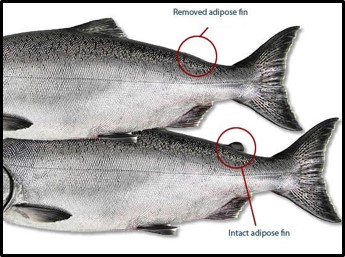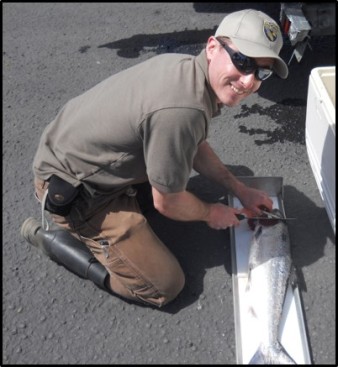7-Year-Old Chinook Part Of 2019 Catch
The following is courtesy of the California Department of Fish and Wildlife:

In July of this year, a commercial salmon troller caught a 7-year-old Central Valley fall-run Chinook salmon (Oncorhynchus tshawytscha) near Bodega Bay that measured 36 inches long.
The occurrence of a 7-year-old Chinook salmon is an extremely unusual event in California waters. In examining over 240,000 tags over the last 38 years, California Department of Fish and Wildlife (CDFW) scientists have only confirmed two other 7-year-old Central Valley Chinook captured in California fisheries. This year’s finding was made by CDFW’s Ocean Salmon Project (OSP) as part of its annual ocean fishery monitoring and coded-wire tag (CWT) recovery efforts.
This fish was produced at the Coleman National Fish Hatchery on the upper Sacramento River, and is the offspring of adults that spawned in 2012. The normal lifespan of California Central Valley Chinook is between two and five years, with the majority of fish returning to spawn as 3-year-olds. Less than 10 percent of these fish return as 5-year-olds.
Each year, approximately 32 million fall-run Chinook salmon are produced at five hatcheries in the Central Valley. Since 1980, a portion of all hatchery fish are tagged with a CWT that is etched with a unique numeric code. Each salmon containing a CWT is also externally marked with a clipped adipose fin to allow for easy visual identification.
State and federal hatcheries have been tagging Central Valley Chinook since 1972, releasing relatively small groups of tagged fish (less than 1 million fish) early on, and transitioning to a more robust marking and tagging program in 2007. Today’s Constant Fractional Marking Program ensures that at least 25 percent of all hatchery Chinook, or roughly 10 million fish, are tagged each year.
During the ocean salmon season, OSP and California Recreational Fisheries Survey field crews sample salmon from all major ports in California north of Point Conception. Salmon heads are taken back to the CWT lab in Santa Rosa, where the CWTs are removed and processed. The CWT lab processes up to 30,000 heads a year.
OSP scientists use sampling data and CWT information to estimate California commercial and recreational ocean salmon landings and fishing effort, and support sustainable ocean and inland salmon fisheries. The information is also used to determine the contribution rates of wild and hatchery salmon stocks to ocean salmon fisheries in California. In addition to supporting the management of California salmon stocks, CWT information sometimes helps to document unusual life histories, like that of this rare 7-year-old salmon.
post by Grace Ghrist, CDFW Environmental Scientist







